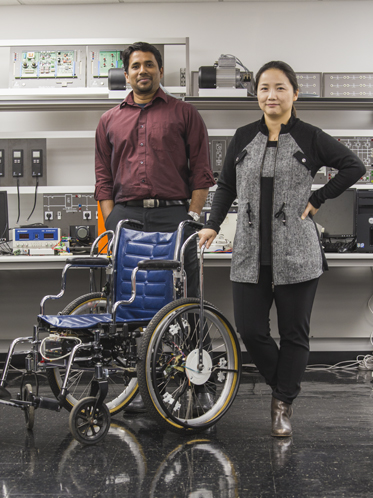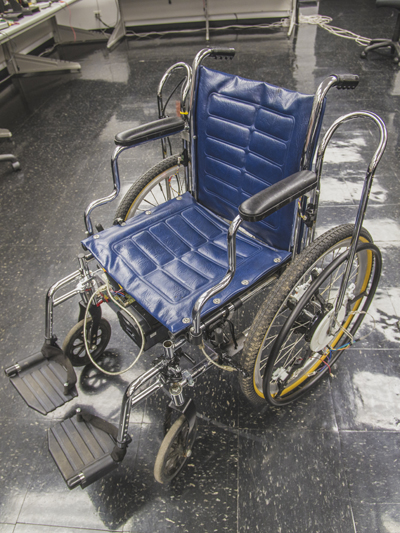Citizen
Scientists
Two Illinois Tech professors—one an engineer and the other a psychologist—are combining efforts in a new area of research known as citizen science, which focuses on the human side of design.
For Mahesh Krishnamurthy, associate professor of electrical and computer engineering, and Eun-Jeong Lee, associate professor of psychology, their form of community-based participant research incorporates end users in the product design—and especially the redesign—process in order to improve the quality of life for people with disabilities.

Photo: Michael Goss
The two began working together two years ago after Krishnamurthy developed an electric wheelchair with “smart” functions such as sensors and adaptive controls, intended to improve the user experience. The focus group segment of the design process was particularly eye opening for him.
“With our wheelchair, we originally thought we had a good solution. But the users brought up so much more. Some thought that the chair was too powerful, that it moved too fast, so there was a perceived sense of danger. As an engineer, I hadn’t thought about those kind of things,” says Krishnamurthy. “It was like building a car with features that no one will use.”

He says that citizen science need not focus on creating new products, but rather improving existing products as well as incorporating participant research into the design process earlier during research and development.
“We’re not trying to reinvent the wheel, because good tech is already available. We’re trying to engineer better solutions, looking at technology from the standpoint of a complete comprehensive service,” he says.
Since 2014 Krishnamurthy and Lee have worked together to teach two Interprofessional Projects (IPRO) Program courses where their student teams have proposed products to help all students maneuver the campus more easily. One team took cues from the Waze map application to create an online, interactive map of Mies Campus. Their map allows users to post notifications alerting fellow users about issues such as icy patches of sidewalk or wheelchair-accessible restrooms that are out of order—situations that can present unique challenges for students with disabilities.
Krishnamurthy and Lee are continuing to test their various projects, including the wheelchair, and have expanded their list of collaborators to include Illinois Tech’s Center for Disability Resources and staff at Richard J. Daley College and Harry S Truman College. Along with Illinois Tech colleagues Anijo Mathew (Institute of Design) and Norman Lederman (Mathematics and Science Education), the two also are in the proposal stage for an initiative that would “create a hub at IIT to focus on the quality of life,” says Krishnamurthy.
“As engineers, we can come up with new technology, but unless we know how it helps the users our work is never complete,” he says.
More Online
“Building Smarter Wheelchairs” in IEEE’s The Institute: theinstitute.ieee.org/technology-topics/consumer-electronics/building-smarter-wheelchairs